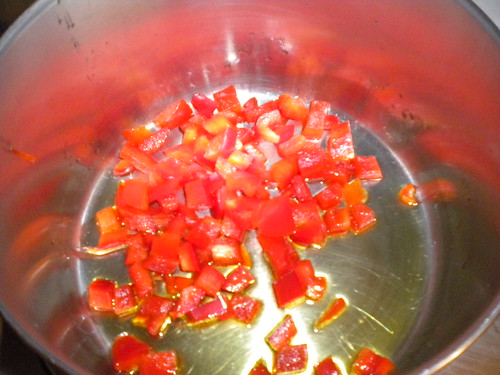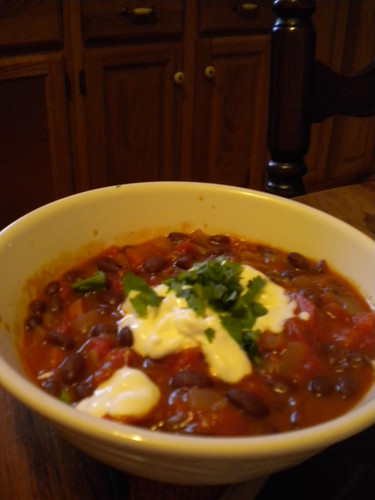Ah, economic vegetarianism, --also known to many as the collegiate or immediately post-collegiate diet. Truthfully, strict economic vegetarianism may not be the best nutrition regimien. Ensuring that one recieves a balance of the full spectrum of vitamins, minerals and nutrients while undertaking a strictly vegetarian diet can be complicated and difficult (but still far from impossible!). Additionally, though I can tell you with certainty that carrots are still cheaper than steak (they also tend to be crunchier. If you like your steak to crunch, you and I should probably never barbecue together), I've never actually done the numbers to prove that a healthy, varied, vegetarian diet is cheaper than a non-vegetarian diet. Food, the costs of production, industrial farming, and the role and effects of social class in our culture are all complicated issues in and of themselves; the point where these concerns converge raises an entire series of complex questions that are far beyond the scope of this blog.
Don't misunderstand though, this is by no means an indictment of vegetarianism! While I would consult a proper nutritionist (or at least get some free advice from the guy who works at the healthfood store) before permanently switching to a strictly vegetarian diet, economic vegetarianism can be a useful general guideline when you're looking to scale back your bills at the grocer's.
Despite a surge in popularity over the past couple of decades, vegetarian food (especially budget-conscious vegetarian food) still gets a bad rap at times. Though the idea that vegetarian fare primarily consists of bland, boiled vegetables persists, it really doesn't have to be like that! My favourite vegetarian dish to make and serve is a black bean chili dish that was inspired by a recipie I once saw in Nutrition Action. (I say inspired because even the first time I made this dish I was unable to follow their recipe due to a combination of my unwillingness to buy what I thought were unnecessary ingridients for something I was sure I was only gonna make once, and my habit of reading the ingridients lists for recipies, but never the directions.) This black bean chili is easy, it's usually cheap to make, and reheats well in the microwave. Though I usually make this chili for myself to take in my lunch during the working-week, I've served it to many of my dinner guests, and always to compliments.
The great thing about this recipie is that once you have it down, you can mix it up a little bit. The tomatoes and red peppers give this dish a natural sweetness that's pleasant underneath the hotter spices, but also does well on it's own as the main flavour of a milder version. It's easy to make, and most of the ingriedents average out to less than 1$ a piece (the unforunate exception to this, is the key ingridient that gives this dish it's subtle sweetness, the red peppers).
BASIC BLACK BEAN CHILI RECIPIE:
-2 tbsp olive oil (or just enough to coat the bottom of whatever pot or pan you use)
-1-2 red bell peppers*
-1-3 cloves of garlic
-1 onion, red or white
-1 lg can of black beans
-1 can of diced tomatoes
-chili powder
-hot sauce (optional)
-salt and pepper
Optional topping:
- sour cream
-fresh cilantro and/or chives
*An alternative to using so many peppers is to use 1/2 to 1 pepper, and then finely chop or grate up a couple of carrots as well. Carrots are usually much cheaper in the produce section and also have a natural sweetness, that enhances wonderfully when the vegetable is cooked.
1) Dice up your bell peppers! If you like chunkier chili, don't worry about dicing them up too finely. I like mine in bits that resemeble 1"-1 1/2" cubes. Set aside
2) Use your olive oil to coat the bottom of your pot or pan (I think the recipie I adapted this 8stove. Turn your stove burner on to medium-low.
3) After your oil starts to warm (I never wait til it's "screaming hot"), dump in the peppers and let them cook in the oil until they become fragrant and a bit shiney (for me, with my stove, this usually ends up being around 5 miuntes).

4) As the peppers are cooking, dice up your garlic and onions. Once they're cut up, dump them into the pot with the peppers.
5) Continue cooking the pepper,garlic, and onions on medium-low until onions start to become translucent (again, this is usually just takes a few minutes, usually around five of them).
6) Drain and lightly rinse the canned beans. Dump beans into the pot with the vegetables.
7) Next, dump canned, diced tomatoes into the chili pot. Your dish should look a bit watery. That's good. You'll know the chili is down when the liquid from the diced tomatoes cooks down.
8) Take your chili powder, and give a few of good shakes into the pot. I use quite a few good shakes and my chili is usually still pretty mild. If you want a spicer dish consider using a full-table spoon, or adding other, hotter spices of your choice.
9) Add any additional seasonings and herbs you'd ike to use to flavor your chili (such as hot sauce). A few of the things I like to add when I have them on hand are: Adobo peppers, Valentina hot sauce, cumin, red pepper flakes and tabasco sauce
10) Stir your chili.
11) Now walk away from it for a while, and let it cook slowly, on medium-low to low until the liquid from the canned tomatoes cooks down (this usually means your chili cooks for an hour or two. Yes, that is a long time; it's worth it).
12) Make sure you check on your chili and stir it up now and then to make sure none of it burns and sticks to the bottom of the pan.
13) After your water has cooked down, turn your burner off, and spoon the chili into a bowl.
14) Top with a dollop of sour cream and fresh cut cilantro and/or chives

15) Eat some chili!
No comments:
Post a Comment